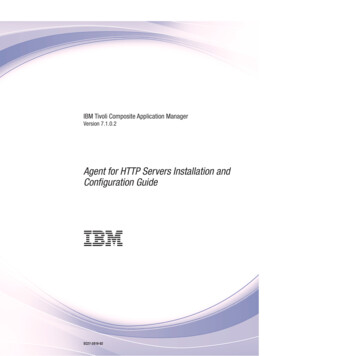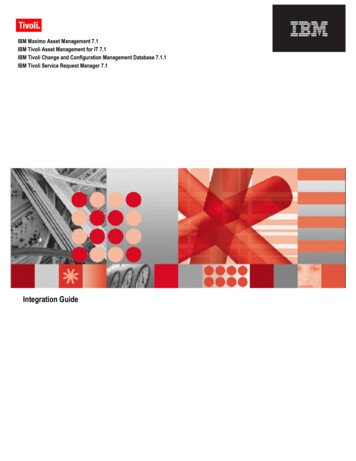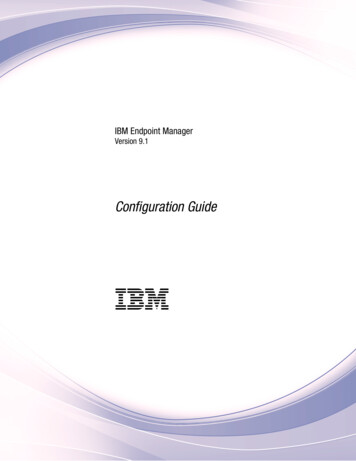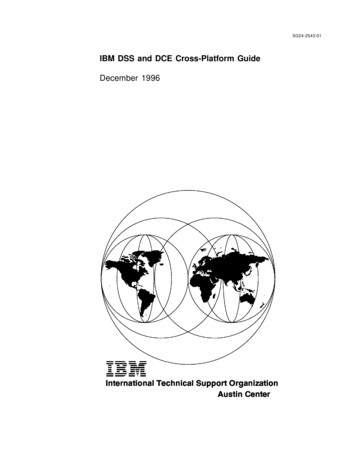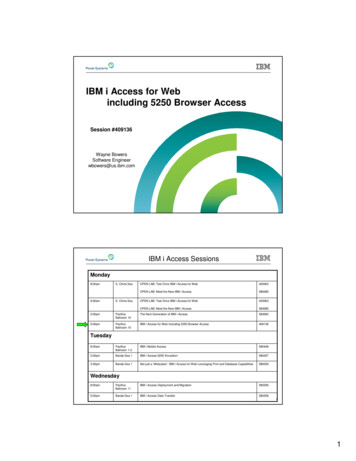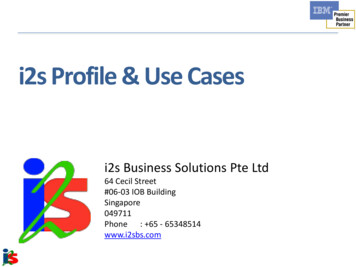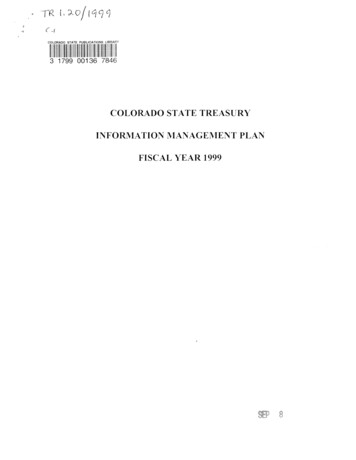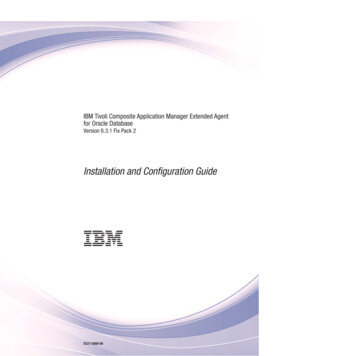
Transcription
IBM Tivoli Composite Application Manager Extended Agentfor Oracle DatabaseVersion 6.3.1 Fix Pack 2Installation and Configuration Guide SC27-5669-00
IBM Tivoli Composite Application Manager Extended Agentfor Oracle DatabaseVersion 6.3.1 Fix Pack 2Installation and Configuration Guide SC27-5669-00
NoteBefore using this information and the product it supports, read the information in “Notices” on page 65.This edition applies to version 6.3.1 Fix Pack 2 of IBM Tivoli Composite Application Manager Extended Agent forOracle Database (product number 5724-I45) and to all subsequent releases and modifications until otherwiseindicated in new editions. Copyright IBM Corporation 2009, 2013.US Government Users Restricted Rights – Use, duplication or disclosure restricted by GSA ADP Schedule Contractwith IBM Corp.
ContentsFigures . . . . . . . . . . . . . . . vTables . . . . . . . . . . . . . . . viiChapter 1. Overview of the agent . . . . 1IBM Tivoli Monitoring . . . . . . . . .Features of the Oracle Database Extended agentFunctions of the monitoring agent . . . . .New in this release . . . . . . . . . .Components of the IBM Tivoli Monitoringenvironment . . . . . . . . . . . .Agent Management Services . . . . . . .User interface options . . . . . . . . .1123. 4. 5. 5Chapter 2. Agent installation andconfiguration . . . . . . . . . . . . 7Requirements . . . . . . . . . . . . . . 7Language pack installation . . . . . . . . . 7Installing language packs on Windows systems . . 7Installing language packs on UNIX or Linuxsystems . . . . . . . . . . . . . . . 8Installing language packs on Windows, UNIX, orLinux systems silently . . . . . . . . . . 8Agent-specific installation and configuration . . . 10Granting privileges . . . . . . . . . . . 11Naming conventions for agent instances anddatabase connections . . . . . . . . . . 14Installation and configuration considerations . . 16Local configuration . . . . . . . . . . . 17Remote installation and configuration . . . . 29 Copyright IBM Corp. 2009, 2013Setting environment variables . . . . . . .Customizing Oracle alert log monitoring . . .Customizing Listener and Net Service monitoringDefining and running customized SQLstatements . . . . . . . . . . . . . .Configuring Top SQL monitoring . . . . . .Configuring agent event monitoring . . . . .Sample Database connection configuration . . .Starting or stopping the agent . . . . . . .Configuring for clustering and positioning in theportal navigator . . . . . . . . . . . .Supported Oracle Call Interface client libraryversions . . . . . . . . . . . . . .ICU regular expressions . . . . . . . . .ICU supported code pages . . . . . . . .333737384042434648495154Appendix. ITCAM for Applicationsdocumentation library . . . . . . . . 61Prerequisite publications . . .Related publications . . . .Tivoli Monitoring Community onManagement Connect . . . .Other sources of documentation. . . . .Service. . . . . 61. 61. 62. 62Notices . . . . . . . . . . . . . . 65Trademarks . . . . . .Privacy policy considerations. 67. 67Index . . . . . . . . . . . . . . . 69iii
ivITCAM Extended Agent for Oracle Database Installation and Configuration Guide
Figures1.2.3.4.5.6.7.8.9.10.11.12.13.14.Launching the installer in the Administratorrole . . . . . . . . . . . . . .32-bit agent check box . . . . . . . .64-bit agent check box . . . . . . . .Launching Manage Tivoli Monitoring Serversin the Administrator role . . . . . . .Entering the instance name for the agentDefault Configuration section of the AgentConfiguration window . . . . . . . .Instance Configuration section of the AgentConfiguration window . . . . . . . .Connection test result . . . . . . . .Select Basic type . . . . . . . . . .Sample input for Basic type . . . . . .Select TNS type . . . . . . . . . .Select Advanced type . . . . . . . .Summary section of the Agent Configurationwindow . . . . . . . . . . . . .SQL result . . . . . . . . . . . . Copyright IBM Corp. 2009, 201315. 17. 17. 17. 171816.17.18.19. 1820.212223232324. 26. 3921.22.23.Sample filter setting in the historical collectionconfigure panel . . . . . . . . . . .Sample Formula setting in the situationconfigure panel . . . . . . . . . . .Agent event situation . . . . . . . . .Use Basic connection type to specify a singleinstance database . . . . . . . . . .Use Advanced connection type to specify aRAC database with more than one instance . .Use Advanced connection type to specify anASM database with more than one instanceand a different user name that hasSYSDBA/SYSASM authority . . . . . . .Database connection for primary node withDEFAULT role . . . . . . . . . . .Database connection for standby node withsysdba role. . . . . . . . . . . . .CTIRA HOSTNAME in portal navigator. . . . .414243444445454648v
viITCAM Extended Agent for Oracle Database Installation and Configuration Guide
Tables1.2.3.4.5.6.7.8.Comparison of local and remote monitoringDefault Configuration attributes. . . . .Instance Configuration section . . . . .Connection type options . . . . . . .Environment variable descriptions . . . .Sample SQL statements in the defaultcustomized SQL template file . . . . .All valid Order By values for the Top SQLmonitoring . . . . . . . . . . . .Levels of the agent events to be sent for eachKRZ EVENT LEVEL . . . . . . . . Copyright IBM Corp. 2009, 2013.1619223233. 39. 409.10.11.12.13.14.15.Suggestions for correcting errors for eventmessages . . . . . . . . . . . . .Interfaces for starting and stopping the OracleDatabase Extended agent . . . . . . . .ITCAM Extended Agent for Oracle Databaseaffinities . . . . . . . . . . . . .Supported OCI library for each platformRegular expression metacharacters . . . . .Regular expression operators. . . . . . .Code page descriptions . . . . . . . .43464849515254. 42vii
viiiITCAM Extended Agent for Oracle Database Installation and Configuration Guide
Chapter 1. Overview of the agentThe IBM Tivoli Composite Application Manager Extended Agent for Oracle Database (product code RZ)provides you with the capability to monitor Oracle Database. You can also use the agent to take basicactions with the Oracle Database.IBM Tivoli Monitoring is the base software for the Oracle Database Extended agent. The OracleDatabase Extended agent monitors Oracle RAC performance, Oracle ASM performance, General Oracledatabase performance, and Data Guard performance.IBM Tivoli MonitoringIBM Tivoli Monitoring provides a way to monitor the availability and performance of all the systems inyour enterprise from one or several designated workstations. It also provides useful historical data thatyou can use to track trends and to troubleshoot system problems.You can use IBM Tivoli Monitoring to achieve the following tasks:v Monitor for alerts on the systems that you are managing by using predefined situations or customsituations.vvvvEstablish your own performance thresholds.Trace the causes leading to an alert.Gather comprehensive data about system conditions.Use policies to take actions, schedule work, and automate manual tasks.The Tivoli Enterprise Portal is the interface for IBM Tivoli Monitoring products. You can use theconsolidated view of your environment as seen in the Tivoli Enterprise Portal to monitor and resolveperformance issues throughout the enterprise.See the IBM Tivoli Monitoring publications listed in “Prerequisite publications” on page 61 for completeinformation about IBM Tivoli Monitoring and the Tivoli Enterprise Portal.Features of the Oracle Database Extended agentUse the Oracle Database Extended agent software to monitor Oracle RAC (Real Application Clusters)databases, ASM (Automatic Storage Management) databases, normal databases, which have a singleOracle instance for each Oracle database, and Oracle Data Guard. Use the software to identify, notify youof, and correct common problems with the application that it monitors. The software includes thefollowing features:v Remote database monitoringYou can install the Oracle Database Extended agent on a different workstation from the one where theOracle database to be monitored is running.v Multiple agent instances monitoringYou can configure and start multiple agent instances.v Multiple database connections monitoring in one agent instanceYou can define multiple database connections to monitor multiple Oracle database by using one agentinstance.v Agent events monitoringYou can find detail information about all triggered events in the Database Connection workspace, anddetermine the problem with the monitored database. Copyright IBM Corp. 2009, 20131
v Oracle database monitoringThe agent monitors Oracle RAC (Real Application Clusters) databases, ASM (Automatic StorageManagement) databases, and normal databases, which have a single Oracle instance for each Oracledatabase.v Data Guard monitoringData Guard provides a set of services that create and maintain standby databases. These standbydatabases are used to enable Oracle databases to switch one standby database to production role incase the primary database is unavailable because of planned or unplanned outage.The agent monitors the Data Guard configuration, the transport activities of redo logs between theprimary database and standby databases, the Redo Apply at physical standby databases, and SQLApply at logical databases.v Topology views for RDBMS (relational database management system) databases, including RACdatabases, and for ASM databases– For RDBMS database connections, including RAC database connections, the agent provides therelationship between the following components:- Services- RDBMS instances- Database– For ASM database connection, the agent provides the relationship between the followingcomponents:- RDBMS instances- Database- ASM instances- ASM disk groups- ASM diskFunctions of the monitoring agentThe Oracle Database Extended agent provides the following functions for Oracle Database 10g release 1,Oracle Database 10g release 2, Oracle Database 11g release 1, and Oracle Database 11g release 2:Oracle RAC performance monitoringOracle Real Application Clusters (RAC) enables a single database to run across a cluster ofservers. The most important services in RAC are GCS (Global Cache Services) and GES (GlobalEnqueue Service). The Oracle Database Extended agent provides the following features tomonitor those two services:v GCS monitoringInformation about the following items is provided:– GCS Memory: the memory that currently used by GCS– GCS Current Block: the received time and served time of the current block– GCS Block Lost: the percentage of block lost during the transfer– GCS CR Latency: the received time and served time of the CR block– GCS Waits: the waiting sessions that are related to GCS– Cache Fusion: the ratio of cache fusionv GES monitoringInformation about the following items is provided:– GES Enqueue Statistics: the contents statistics in GES– GES Latency: the latency statistics in GES– GES Lock: current locks in GES2ITCAM Extended Agent for Oracle Database Installation and Configuration Guide
– GES Memory: the memory that currently used by GES– Messaging Statistics: the time to process messages in GCS and GESOracle ASM performance monitoringOracle ASM is a volume manager and a file system for Oracle database files. The followingfeatures are provided for ASM monitoring:v ASM topology monitoring, providing the topology of ASM instances, ASM disk groups, andASM disksv ASM alert log monitoringv ASM availability monitoringv ASM capacity monitoring, providing information about ASM disk groups, ASM disks, andASM files.v ASM IO statistics, providing the I/O statistics of ASM disk groups, I/O statistics of ASM disks,and information about ASM operations.General Oracle database performance monitoringThe Oracle Database Extended agent provides monitoring for the availability, performance,resource usage, and activities of the Oracle database.v Availability of instances in the monitored Oracle databasev Resource information such as memory, caches, segments, resource limitation, tablespace, undo(rollback), system metric, and system statisticsv Activity information such as OS statistics, sessions, contention, and alert logData Guard performance monitoringThis function provides information about alert logs, Data Guard configuration, Redo Apply, SQLApply, and transport of redo logs.New in this releaseFor version 6.3.1 Fix Pack 2 of the Oracle Database Extended agent, enhancements were made sinceversion 6.3.1.The following enhancements were made:v User interface configuration improvements.– Simplifies the database connection configuration with three connection types:- Basic: Oracle database server host name (or IP address), Listener port, and Oracle database servicename (or Oracle SID) must be specified.- TNS: only the TNS Alias must be specified or selected from the drop-down list that is discoveredfrom the ORACLE HOME/network/admin/tnsnames.ora file.- Advanced: only the Oracle connection string must be specified to be compatible with an oldversion of agent configuration.– -Supports the following connection string format: "//hostname:port/ORACLE SID".– At least one database connection must be added during the GUI configuration.v New environment variables that you can use to customize the agent, such as KRZ LISTENER INCLUDE,KRZ LISTENER EXCLUDE, KRZ TNS INCLUDE, KRZ TNS EXCLUDE, KRZ REDIRECT TNS, KRZ EVENT LEVEL, andKRZ SQL PREFILTER.– Provides the option to control whether the agent monitors the specific Listener name and Oracle netservice end points. Both including and excluding filters are provided (KRZ LISTENER INCLUDE,KRZ LISTENER EXCLUDE, KRZ TNS INCLUDE, KRZ TNS EXCLUDE).– Provides the option (KRZ REDIRECT TNS) to control whether to redirect the value of the predefinedTNS ADMIN environment variable to the agent log directory to disable the Oracle sqlnet.log.Chapter 1. Overview of the agent3
– Provides the option (KRZ EVENT LEVEL) to control which level of agent event is sent. The level with ascope from high to low is MISC, INFO, WARN, or ERROR.– Provides the option (KRZ SQL PREFILTER) to control whether the agent combines the filterinformation in the SQL query that is sent to the Oracle database for the data processing.v Performance improvement for Top SQL monitoring.v Disk Space usage monitoring for Archive Destination when Archive destination is defined in the Oracledatabase as USE DB RECOVERY FILE DEST instead of a real physical directory.v More SQL statement samples in the krzcussql.properties customized SQL template file for OracleJobs, Oracle Users, and Oracle Queues monitoring.Components of the IBM Tivoli Monitoring environmentAfter you install and set up the Oracle Database Extended agent, you have an environment that containsthe client, server, and monitoring agent implementation for Tivoli Monitoring.This Tivoli Monitoring environment contains the following components:Tivoli Enterprise Portal clientThe portal has a user interface based on Java for viewing and monitoring your enterprise.Tivoli Enterprise Portal ServerThe portal server is placed between the client and the Tivoli Enterprise Monitoring Server andenables retrieval, manipulation, and analysis of data from the monitoring agents. The TivoliEnterprise Portal Server is the central repository for all user data.Tivoli Enterprise Monitoring ServerThe monitoring server acts as a collection and control point for alerts received from themonitoring agents, and collects their performance and availability data. The Tivoli EnterpriseMonitoring Server is also a repository for historical data.Tivoli Enterprise Monitoring Agent, Oracle Database Extended agent (one or more instances of themonitoring agent).The instances communicate with the systems or subsystems that you want to monitor. Thismonitoring agent collects and distributes data to a Tivoli Enterprise Portal Server.IBM Tivoli Netcool/OMNIbusTivoli Netcool/OMNIbus is an optional component and the recommended event managementcomponent. The Netcool/OMNIbus software is a service level management (SLM) system thatdelivers real-time, centralized monitoring of complex networks and IT domain events. Eventinformation is tracked in a high-performance, in-memory database and presented to specific usersthrough individually configurable filters and views. The software includes automation functionsthat you can use to perform intelligent processing on managed events. You can use this softwareto forward events for Tivoli Monitoring situations to Tivoli Netcool/OMNIbus.IBM Tivoli Enterprise Console The Tivoli Enterprise Console is an optional component that acts as a central collection point forevents from various sources, including events from other Tivoli software applications, Tivolipartner applications, custom applications, network management platforms, and relationaldatabase systems. You can view these events through the Tivoli Enterprise Portal (by using theevent viewer), and you can forward events from Tivoli Monitoring situations to the TivoliEnterprise Console component. If you do not already use Tivoli Enterprise Console and need anevent management component, you can choose to use IBM Tivoli Netcool/OMNIbus.The Tivoli Business Service Manager component delivers real-time information to help yourespond to alerts effectively based on business requirements. Optionally, you can use thiscomponent to meet service-level agreements (SLAs). Use the Tivoli Business Service Managertools to help build a service model that you can integrate with Tivoli Netcool/OMNIbus alerts or4ITCAM Extended Agent for Oracle Database Installation and Configuration Guide
optionally integrate with data from an SQL data source. Optional components provide access todata from other IBM Tivoli applications such as Tivoli Monitoring and TADDM.Agent Management ServicesYou can use IBM Tivoli Monitoring Agent Management Services to manage the Oracle Database Extendedagent.Agent Management Services is available for the following IBM Tivoli Monitoring OS agents: Windows,Linux, and UNIX. The services are designed to keep the Oracle Database Extended agent available, andto provide information about the status of the product to the Tivoli Enterprise Portal. For moreinformation about Agent Management Services, see “Agent Management Services” in the IBM TivoliMonitoring Administrator's Guide.User interface optionsInstallation of the base IBM Tivoli Monitoring software and other integrated applications providesvarious interfaces that you can use to work with your resources and data.The following interfaces are available:Tivoli Enterprise Portal user interfaceYou can run the Tivoli Enterprise Portal as a desktop application or a browser application. Theclient interface is a graphical user interface (GUI) based on Java on a Windows or Linuxworkstation. The browser application is automatically installed with the Tivoli Enterprise PortalServer. The desktop application is installed by using the Tivoli Monitoring installation media orwith a Java Web Start application. To start the Tivoli Enterprise Portal browser client in yourInternet browser, enter the URL for a specific Tivoli Enterprise Portal browser client installed onyour Web server.Command-line interfaceYou can use Tivoli Monitoring commands to manage the Tivoli Monitoring components and theirconfiguration. You can also run commands at the Tivoli Enterprise Console event server or theTivoli Netcool/OMNIbus ObjectServer to configure event synchronization for enterprisesituations.Manage Tivoli Enterprise Monitoring Services windowYou can use the window for the Manage Tivoli Enterprise Monitoring Services utility to configurethe agent and start Tivoli services not designated to start automatically.IBM Tivoli Netcool/OMNIbus event listYou can use the Netcool/OMNIbus event list to monitor and manage events. An event is createdwhen the Netcool/OMNIbus ObjectServer receives an event, alert, message, or data item. Eachevent is made up of columns (or fields) of information that are displayed in a row in theObjectServer alerts.status table. The Tivoli Netcool/OMNIbus web GUI is also a web-basedapplication that processes network events from one or more data sources and presents the eventdata in various graphical formats.IBM Tivoli Enterprise ConsoleYou can use the Tivoli Enterprise Console to help ensure the optimal availability of an IT servicefor an organization. The Tivoli Enterprise Console is an event management application thatintegrates system, network, database, and application management. If you do not already useTivoli Enterprise Console and need an event management component, you can choose to useTivoli Netcool/OMNIbus.Chapter 1. Overview of the agent5
6ITCAM Extended Agent for Oracle Database Installation and Configuration Guide
Chapter 2. Agent installation and configurationAgent installation and configuration requires the use of the IBM Tivoli Monitoring Installation and SetupGuide and agent-specific installation and configuration information.To install and configure the Oracle Database Extended agent, use the “Installing monitoring agents”procedures in the IBM Tivoli Monitoring Installation and Setup Guide along with the agent-specificinstallation and configuration information.If you are installing silently by using a response file, see “Performing a silent installation of IBM TivoliMonitoring” in the IBM Tivoli Monitoring Installation and Setup Guide.With the self-describing agent capability, new or updated IBM Tivoli Monitoring agents using IBM TivoliMonitoring V6.2.3 or later can become operational after installation without having to perform additionalproduct support installation steps. To take advantage of this capability, see “Enabling self-describingagent capability at the hub monitoring server” in the IBM Tivoli Monitoring Installation and Setup Guide.Also, see “Self-describing monitoring agents” in the IBM Tivoli Monitoring Administrator's Guide.RequirementsBefore installing and configuring the agent, make that sure your environment meets the requirements forthe IBM Tivoli Composite Application Manager Extended Agent for Oracle Database.For information about system requirements, see the Prerequisites topic /v24r1/topic/com.ibm.itcama.doc 7.2.1/prerequisites/apps721 systemreqs.html) in theIBM Tivoli Composite Application Manager for Applications Information Center.Language pack installationThe steps for installing language packs depend on which operating system and mode of installation youare using.To install a language pack for the agent support files on the Tivoli Enterprise Monitoring Server, theTivoli Enterprise Monitoring Agent, and the Tivoli Enterprise Portal Server, make sure that you installedthe product in the English language. Then use the steps for the operating system or mode of installationyou are using:v “Installing language packs on Windows systems”v “Installing language packs on UNIX or Linux systems” on page 8v “Installing language packs on Windows, UNIX, or Linux systems silently” on page 8Installing language packs on Windows systemsYou can install the language packs on a Windows system.Before you beginFirst, make sure that you installed the product in the English language.Procedure1. On the language pack CD, double-click the lpinstaller.bat file to start the installation program.2. Select the language of the installer and click OK.3. In the Introduction panel, click Next Copyright IBM Corp. 2009, 20137
4. Click Add/Update and click Next.5. Select the folder where the National Language Support package (NLSPackage) files are located.Typically, the NLSPackage files are located in the nlspackage folder where the installer executablefile is located.6. Select the language support for the agent of your choice and click Next. To make multiple selections,press Ctrl and select the language that you want.7.8.9.10.Select the languages that you want to install and click Next.Examine the installation summary page and click Next to begin installation.After installation completes, click Finish to exit the installer.Restart the Tivoli Enterprise Portal, Tivoli Enterprise Portal Server, and Eclipse Help Server if any ofthese components are installed.Installing language packs on UNIX or Linux systemsYou can install the language packs on a UNIX or Linux system.Before you beginFirst, make sure that you installed the product in the English language.Procedure1. Enter the mkdir command to create a temporary directory on the computer, for example, mkdirdir name. Make sure that the full path of the directory does not contain any spaces.2. Mount the language pack CD to the temporary directory that you created.3. Enter the following command to start the installation program: cd dir name lpinstaller.sh -cinstall dir where install dir is where you installed IBM Tivoli Monitoring. Typically, the directoryname is /opt/IBM/ITM for UNIX and Linux systems.4. Select the language of the installer and click OK.5. In the Introduction panel, click Next.6. Click Add/Update and click Next.7. Select the folder where the National Language Support package (NLSPackage) files are located.Typically, the NLSPackage files are located in the nlspackage folder where the installer executable fileis located.8. Select the language support for the agent of your choice and click Next. To make multiple selections,press Ctrl and select the language that you want.9.10.11.12.Select the languages that you want to install and click Next.Examine the installation summary page and click Next to begin installation.After installation completes, click Finish to exit the installer.Restart the Tivoli Enterprise Portal, Tivoli Enterprise Portal Server, and Eclipse Help Server if any ofthese components are installed.Installing language packs on Windows, UNIX, or Linux systems silentlyYou can use the silent-mode installation method to install the language packs. In silent mode, theinstallation process obtains the installation settings from a predefined response file. It does not promptyou for any information.Before you beginFirst, make sure that you installed the product in the English language.8ITCAM Extended Agent for Oracle Database Installation and Configuration Guide
Procedure1. Copy and paste the ITM Agent LP silent.rsp response file template as shown in “Response fileexample.”2. Change the following parameter settings:NLS PACKAGE FOLDERFolder where the National Language Support package (NLSPackage) files are located.Typically, the NLSPackage files are located in the nlspackage folder, for example:NLS PACKAGE FOLDER //tmp//LP//nlspackage.PROD SELECTION PKGName of the language pack to install. Several product components can be included in onelanguage package. You might want to install only some of the available components in alanguage pack.BASE AGENT FOUND PKG LISTAgent for which you are installing language support. This value is usually the same asPROD SELECTION PKG.LANG SELECTION LISTLanguage you want to install.3. Enter the command to install the language pack with a response file (silent installation):v For Windows systems:lpinstaller.bat -f path to response filev For UNIX or Linux systems:lpinstaller.sh -c candle home -f path to response filewhere candle home is the IBM Tivoli Monitoring base directory.Response file example#IBM Tivoli Monitoring Agent Language Pack Silent Installation Operation##This is a sample response file for silent installation mode for the IBM Tivoli#Monitoring Common Language Pack Installer.#.#This file uses the IBM Tivoli Monitoring Common Agent Language Pack with the#install package as an example.#Note:#This response file is for the INSTALLATION of language packs only.#This file does not support UNINSTALLATION of language packs in silent -------------#To successfully complete a silent installation of the the example of Common Agent#localization pack, complete the following steps:##1.Copy ITM Agent LP silent.rsp to the directory where lpinstaller.bat or#lpinstaller.sh is located (IBM Tivoli Monitoring Agent Language Pack build#location).##2.Modify the response file so that it is customized correctly and completely for#your site.# Complete all of the following steps in the response file.##3.After customizing the response file, invoke the silent installation using the#following command:#For Windows:#lpinstaller.bat -f path to response file #For UNIX and Linux:#lpinstaller.sh -c candle home -f path to response file #Note: candle home is the IBM Tivoli Monitoring base ----------------------------------------Chapter 2. Agent installation and configuration9
------------------------------#Force silent install -----------------------------------INSTALLER UI -------------------------------------#Run add and update ---------------------------------------CHOSEN INSTALL SET ADDUPD ----------------------------------#NLS Package Folder, where the NLS Packages exist.#For Windows:# Use the backslash-backslash(\\) as a file separator (for r UNIX and Linux:# Use the slash-slash (//) as a file separator (for ---------------------------------#NLS PACKAGE FOLDER C:\\zosgmv\\LCD7-3583-01\\nlspackageNLS PACKAGE FOLDER --#List the packages to process; both vari
databases, ASM (Automatic Storage Management) databases, normal databases, which have a single Oracle instance for each Oracle database, and Oracle Data Guard. Use the software to identify, notify you of, and correct common problems with the application that it monitors. The software includes the following features: v Remote database monitoring



